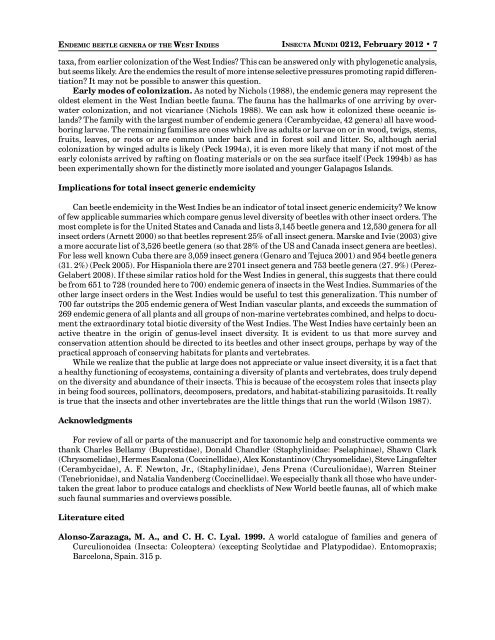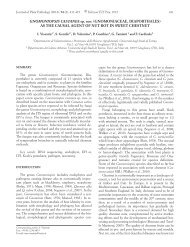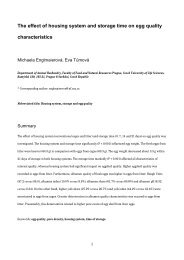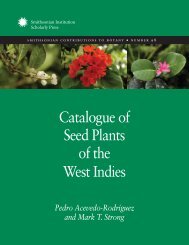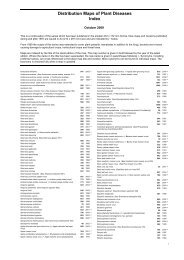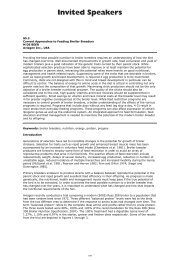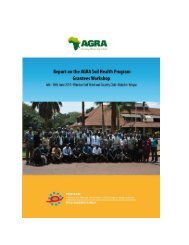0212 insecta mundia - CABI
0212 insecta mundia - CABI
0212 insecta mundia - CABI
Create successful ePaper yourself
Turn your PDF publications into a flip-book with our unique Google optimized e-Paper software.
ENDEMIC BEETLE GENERA OF THE WEST INDIES<br />
INSECTA MUNDI <strong>0212</strong>, February 2012 • 7<br />
taxa, from earlier colonization of the West Indies? This can be answered only with phylogenetic analysis,<br />
but seems likely. Are the endemics the result of more intense selective pressures promoting rapid differentiation?<br />
It may not be possible to answer this question.<br />
Early modes of colonization. As noted by Nichols (1988), the endemic genera may represent the<br />
oldest element in the West Indian beetle fauna. The fauna has the hallmarks of one arriving by overwater<br />
colonization, and not vicariance (Nichols 1988). We can ask how it colonized these oceanic islands?<br />
The family with the largest number of endemic genera (Cerambycidae, 42 genera) all have woodboring<br />
larvae. The remaining families are ones which live as adults or larvae on or in wood, twigs, stems,<br />
fruits, leaves, or roots or are common under bark and in forest soil and litter. So, although aerial<br />
colonization by winged adults is likely (Peck 1994a), it is even more likely that many if not most of the<br />
early colonists arrived by rafting on floating materials or on the sea surface itself (Peck 1994b) as has<br />
been experimentally shown for the distinctly more isolated and younger Galapagos Islands.<br />
Implications for total insect generic endemicity<br />
Can beetle endemicity in the West Indies be an indicator of total insect generic endemicity? We know<br />
of few applicable summaries which compare genus level diversity of beetles with other insect orders. The<br />
most complete is for the United States and Canada and lists 3,145 beetle genera and 12,530 genera for all<br />
insect orders (Arnett 2000) so that beetles represent 25% of all insect genera. Marske and Ivie (2003) give<br />
a more accurate list of 3,526 beetle genera (so that 28% of the US and Canada insect genera are beetles).<br />
For less well known Cuba there are 3,059 insect genera (Genaro and Tejuca 2001) and 954 beetle genera<br />
(31. 2%) (Peck 2005). For Hispaniola there are 2701 insect genera and 753 beetle genera (27. 9%) (Perez-<br />
Gelabert 2008). If these similar ratios hold for the West Indies in general, this suggests that there could<br />
be from 651 to 728 (rounded here to 700) endemic genera of insects in the West Indies. Summaries of the<br />
other large insect orders in the West Indies would be useful to test this generalization. This number of<br />
700 far outstrips the 205 endemic genera of West Indian vascular plants, and exceeds the summation of<br />
269 endemic genera of all plants and all groups of non-marine vertebrates combined, and helps to document<br />
the extraordinary total biotic diversity of the West Indies. The West Indies have certainly been an<br />
active theatre in the origin of genus-level insect diversity. It is evident to us that more survey and<br />
conservation attention should be directed to its beetles and other insect groups, perhaps by way of the<br />
practical approach of conserving habitats for plants and vertebrates.<br />
While we realize that the public at large does not appreciate or value insect diversity, it is a fact that<br />
a healthy functioning of ecosystems, containing a diversity of plants and vertebrates, does truly depend<br />
on the diversity and abundance of their insects. This is because of the ecosystem roles that insects play<br />
in being food sources, pollinators, decomposers, predators, and habitat-stabilizing parasitoids. It really<br />
is true that the insects and other invertebrates are the little things that run the world (Wilson 1987).<br />
Acknowledgments<br />
For review of all or parts of the manuscript and for taxonomic help and constructive comments we<br />
thank Charles Bellamy (Buprestidae), Donald Chandler (Staphylinidae: Pselaphinae), Shawn Clark<br />
(Chrysomelidae), Hermes Escalona (Coccinellidae), Alex Konstantinov (Chrysomelidae), Steve Lingafelter<br />
(Cerambycidae), A. F. Newton, Jr., (Staphylinidae), Jens Prena (Curculionidae), Warren Steiner<br />
(Tenebrionidae), and Natalia Vandenberg (Coccinellidae). We especially thank all those who have undertaken<br />
the great labor to produce catalogs and checklists of New World beetle faunas, all of which make<br />
such faunal summaries and overviews possible.<br />
Literature cited<br />
Alonso-Zarazaga, M. A., and C. H. C. Lyal. 1999. A world catalogue of families and genera of<br />
Curculionoidea (Insecta: Coleoptera) (excepting Scolytidae and Platypodidae). Entomopraxis;<br />
Barcelona, Spain. 315 p.


